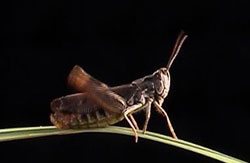Less is more – Grasshoppers detect species-specific songs with few cells

The ears of grasshoppers are located in the abdomen; neurons that are also important for sound processing are in the thorax region. Only highly filtered information reaches the brain. © Sandra Wohlgemuth<br>
They investigated how the auditory system of grasshoppers recognizes species-specific courtship songs and found that only three cellular interconnections are needed for song identification. Furthermore, it does not matter that the signals transduced to the brain are far less precise than the input signals.
Millions of stimuli affect us, but only a fraction of these is important to us. The stimuli are filtered by the sensory organs and preprocessed so that our brain is able to track what is important without becoming overwhelmed. The retina, for instance, does not only send single pixel information to the brain, but also information about movements and edges. For this purpose, a large network of thousands of cells is necessary. However, in many animals the neuronal networks of the sensory organs are much more simply constructed. Researchers led by Prof. Bernhard Ronacher, Prof. Susanne Schreiber and Dr. Sandra Wohlgemuth of the Bernstein Center and the Humboldt Universität in Berlin wondered how efficiently simple networks can perform the preprocessing of complex stimuli.
Therefore, they examined the auditory system of grasshoppers, which is important for the recognition of species-specific courtship songs. The studied neurons are found in the thoracic ganglia of the animals. The researchers discovered to their surprise that after three cellular processing steps the information was already heavily modified, and, above all, temporally inaccurate. However, the neuronal signals that were transmitted to the brain contained the essential information about song features.
The courtship songs of different grasshopper species are characterized by alternating sounds and pauses. The activity of the sensory cells that sit in the ear on the abdomen of the animals was precisely temporally coupled with the incoming stimulus patterns. This allows the animals a very accurate classification of the patterns of courtship songs. But already the following cells showed a specific pattern of activity that forwarded only a fraction of the information. “At the beginning, we were very surprised that the network destroys that important precision,” says first author Jan Clemens. However, their analysis shows the reason for the change in signals. “While at the beginning of processing, most information lies in the precise timing of neuronal signals, the output signals are rather a yes-no answer,” says group leader Susanne Schreiber. Thus, many details are lost on the way to the grasshoppers’ brain, but the essential content about song features is much more readily available to the animal.
Thus, this small network also matches the prediction that information processing should be highly efficient in nervous systems in order to survive in evolution. For the next step, the scientists in Berlin aim to rebuild this neuronal network on the computer in order to understand such important data processing more thoroughly.
The Bernstein Center Berlin is part of the National Bernstein Network Computational Neuroscience (NNCN) in Germany. The NNCN was established by the German Federal Ministry of Education and Research with the aim of structurally interconnecting and developing German capacities in the new scientific discipline of computational neuroscience. It was named in honor of the German physiologist Julius Bernstein (1835–1917).
Original publication:
Clemens J, Kutzki O, Ronacher B, Schreiber S*, Wohlgemuth S* (2011): Efficient transformation of an auditory population code in a small sensory system, PNAS doi:10.1073/pnas.1104506108, *equal contribution
http://www.pnas.org/content/early/2011/08/03/1104506108.abstract
Contact person:
Professor Dr. Susanne Schreiber
s.schreiber@hu-berlin.de
Institute for Theoretical Biology
Humboldt-Universität zu Berlin
Invalidenstr. 43
10115 Berlin
Phone: ++49-30-2093 8652
Jan Clemens
clemensjan@gmail.com
Institute for Biology / Behavioral Physiology Group
Humboldt-Universität zu Berlin
Invalidenstraße 43
10115 Berlin
Phone: ++49-30-2093-8777
Media Contact
All latest news from the category: Life Sciences and Chemistry
Articles and reports from the Life Sciences and chemistry area deal with applied and basic research into modern biology, chemistry and human medicine.
Valuable information can be found on a range of life sciences fields including bacteriology, biochemistry, bionics, bioinformatics, biophysics, biotechnology, genetics, geobotany, human biology, marine biology, microbiology, molecular biology, cellular biology, zoology, bioinorganic chemistry, microchemistry and environmental chemistry.
Newest articles

Properties of new materials for microchips
… can now be measured well. Reseachers of Delft University of Technology demonstrated measuring performance properties of ultrathin silicon membranes. Making ever smaller and more powerful chips requires new ultrathin…

Floating solar’s potential
… to support sustainable development by addressing climate, water, and energy goals holistically. A new study published this week in Nature Energy raises the potential for floating solar photovoltaics (FPV)…

Skyrmions move at record speeds
… a step towards the computing of the future. An international research team led by scientists from the CNRS1 has discovered that the magnetic nanobubbles2 known as skyrmions can be…





















